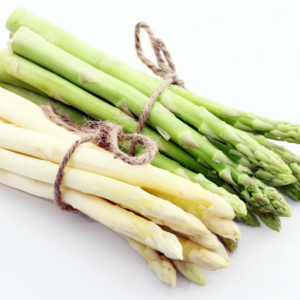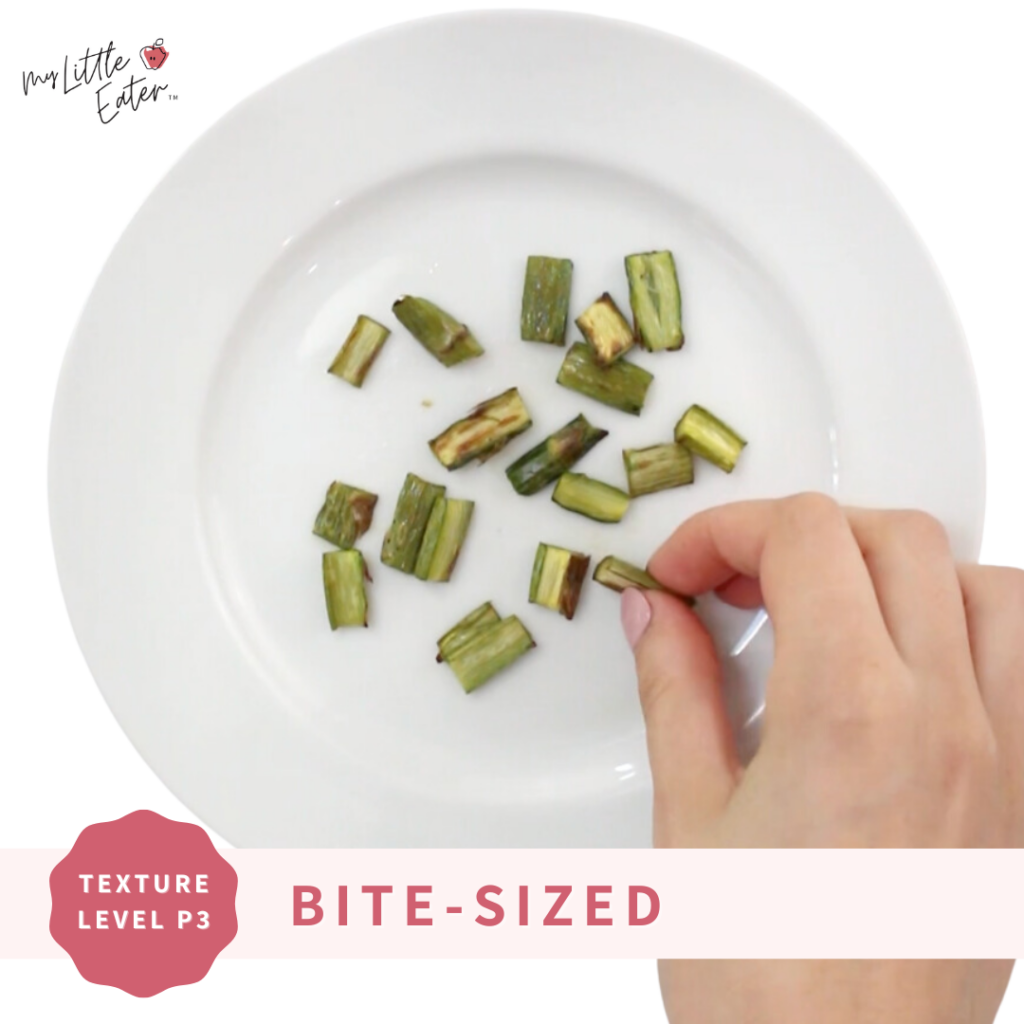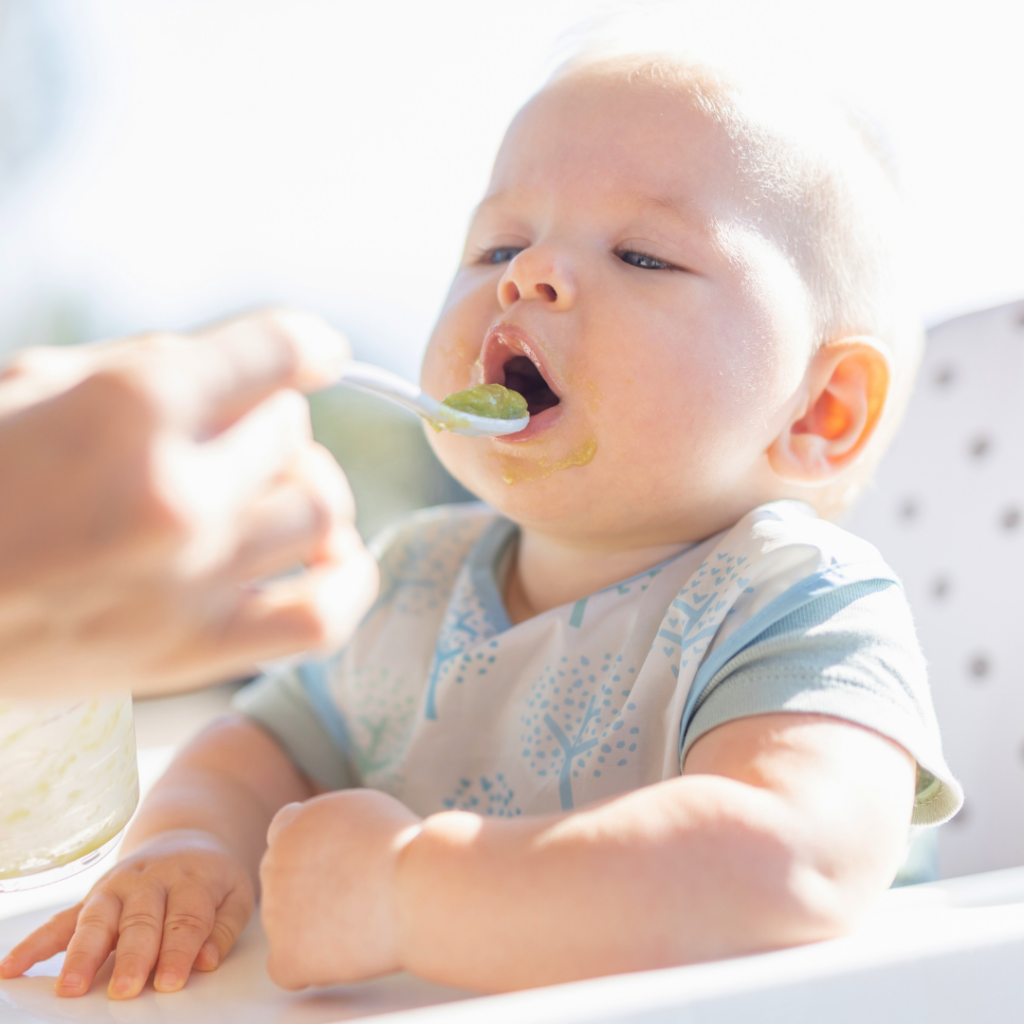- No Comments
- Chelsey Landry, RD & Mallory Roberts, SLP
- Updated: November 5, 2024
This post may contain affiliate links, please view our disclosure policy for more details.
We are huge advocates for serving vegetables right from the start, and asparagus is one of our favorites!
As a green veggie, it’s one of the vegetables that are more likely to be refused in toddlerhood when picky eating behaviors begin to emerge, so early and frequent exposure is key to help decrease that risk. Plus, it falls on both phase 0 and phase 3 of our Texture Timeline™ making it perfect for parents who are a bit more hesitant to get started and parents who want to jump right in!
Let’s go through everything you need to know about this vegetable, including choking risk, how to serve it safely, and nutritional benefits.

Table of Contents
If you’re getting ready to start solids with your little one, or maybe you already have but don’t know what to do next, check out our Baby Led Feeding Program!
Complete with video lessons, printable resources, and full access to our Texture Timeline™ Food Video Library, you’ll know every step you need to take and how to serve all foods safely.
When can babies eat asparagus?
Babies can eat asparagus as soon as they’re ready to start solids, which is typically around 6 months old. We recommend watching for all of the developmental signs of readiness before offering any solid foods – purees or finger foods – to your baby.
Baby Charley tries asparagus!
Baby Charley tries asparagus!
Charley is about 7 months in this video and is trying cooked asparagus, served as a whole spear (phase 3), for the first time.
Is asparagus a choking hazard for babies?
Yes.
Asparagus spears are firm, fibrous, and can be tough to chew, causing them to be a choking hazard if not offered to your baby appropriately. Asparagus should be cooked until it’s soft before serving to minimize the risk of choking (except during phase 0).
Since asparagus is naturally cylindrical in shape, it’s best to cut the asparagus spears lengthwise to further reduce the risk of choking.

Choosing fresh asparagus for your baby
When buying fresh asparagus for baby, there are a few things to look for to make sure it’s ripe (1):
- Spears should be firm and straight with tips that are closed; avoid any that are limp or have tips that are beginning to open
- Spears should be rich in color; avoid any that are dull as these are past the point of freshness
- The texture should be smooth; avoid any that are beginning to wrinkle
Did you know...
Did you know...
Asparagus produces both green and white spears?
Typically, we only see green in our grocery stores, but white spears are delicious too!

How to serve asparagus according to the Texture Timeline™
These are the safest, suggested ways to serve food to your baby based on the scientific, developmental, and clinical research and expertise available to date and are vetted by pediatric doctors, speech-language pathologists, and dietitians. However, please note that babies can technically choke on anything, including purees. Always take into account your child’s individual abilities and needs and check with your doctor or feeding therapist on the safety of offering these foods to your baby. Be mindful of how to set up a safe eating environment and please know that all material, opinions, advice, and information found on mylittleeater.com is for informational and educational purposes only. See our disclaimer for more information.
The very first step is always to thoroughly wash your vegetables before cutting them. You can clean asparagus spears by rinsing them underwater and gently rubbing the skin with your hands to remove any residue.
Texture Timeline™ Phase 0
Whole + raw (Palmar Grasp)

For this phase in particular, it’s important to purchase very fresh and firm asparagus to ensure it acts as a resistive whole food, as intended.
Step 1: Place the washed asparagus on a cutting board. Cut off the softer top of the asparagus, as the little flakes could come off in your baby’s mouth.
Step 2: Once the soft top of the asparagus has been removed, you’ll be left with a hard asparagus stalk for your baby to explore with little to no choking risk.
This makes for a good highly resistive, whole food for your baby before they have teeth and the ability to take bites.
It’s a great way for your baby to begin exploring their mouth, as well as new flavors and rough/bumpy textures with a very low risk of choking due to the large, long shape.
Once your baby has developed the ability to bite and/or break off chunks, especially with teeth, asparagus should no longer be offered this way and the phase 3 method should be used.
Texture Timeline™ Phase 3
Whole + cooked (Palmar Grasp)

Step 1: Place the washed asparagus on a cutting board. Cut off the woody end (bottom) of the asparagus.
Step 2: Cook the asparagus by roasting or steaming (in a pan). These are the best cooking methods for asparagus as it will make them soft but not completely limp. Coat the asparagus in a bit of olive oil or butter (if roasting), and cook until soft (about 15 minutes at 425°F for roasting).
Step 3: Offer the cooked asparagus stalks as a whole. This provides a great fibrous and stringy texture for your baby to experience.
Texture Timeline™ Phase 3
Bite-sized (Pincer grasp)

Repeat the first two steps above. Slice the soft, cooked asparagus in half lengthwise. Cut the asparagus into bite-sized pieces for your baby to pick up with their pincer grasp.
They can also be served with a preloaded fork, or you can try folding them into an omelet, mashed potatoes, or other puree/finger food.
Keep in mind that babies should be introduced to a variety of flavors and spices as well. Asparagus pairs well with garlic or black pepper, as well as olive oil, butter, fresh lemon juice, and even parmesan cheese. Switch it up and try a few different flavor pairings when cooking asparagus for your baby.
Nutritional benefits of asparagus for baby
Asparagus is a healthy addition to your baby’s diet as it provides important vitamins and minerals (2). The most notable vitamins and minerals include:
- Vitamins B6 and B12: Important for helping your little one break down nutrients like protein and carbohydrates (2). They also keep their heart healthy by maintaining healthy levels of homocysteine (an amino acid) in their blood (2).
- Folate: A vitamin that plays a crucial role in maintaining healthy cells and the formation of DNA (2).
- Antioxidants: Beneficial for maintaining healthy cells and optimal brain function (2).

Asparagus also provides some dietary fiber and iron, however, there is only a very small amount of iron found in asparagus, and therefore, it isn’t a reliable source to meet your baby’s high iron needs (2). Dietary fiber will help your little one maintain healthy digestion and beneficial gut bacteria.
Can babies be allergic to asparagus spears?
Asparagus is not one of the top 10 highly allergenic foods and can be introduced alongside other non-highly allergenic foods without having to wait (the 2-day wait rule is for top allergens only). However, this doesn’t mean that your baby can’t develop an allergic reaction.
Asparagus can cause allergic contact dermatitis, also known as ACD, causing an itchy rash when in direct contact with the allergen (3). This is the most common reaction seen with asparagus allergies. Asparagus can induce IgE-mediated allergic reactions, however, very few cases have been reported (3).

Does asparagus affect your baby's urine?
Asparagus makes your urine smelly but only some people can actually smell it (4). Genetic differences occur in olfactory (smell) receptors that cause some people to be able to smell these odorous compounds released in urine, while some won’t (4).
When asparagus is digested, chemicals break down into sulfur-containing and ammonia compounds, causing the smell (4). Don’t be alarmed if you serve your baby asparagus and they have stronger-smelling pee – this is normal and isn’t harmful in any way!
If you’re ready to start solids or have started and don’t know what to serve or do next, check out our Baby Led Feeding Program! With video lessons, printable resources, and full access to our Texture Timeline™ Food Video Library, you’ll have everything you need to make this milestone more enjoyable and less stressful.

Pin this info to save it for later!

References
- https://www.allrecipes.com/article/how-to-store-asparagus/
- Pegiou, E., Mumm, R., Acharya, P., de Vos, R. C., & Hall, R. D. Green and white asparagus (Asparagus officinalis): A source of developmental, chemical and urinary intrigue. Metabolites, 10(1), 17, 2019.
- Tabar, A. I., Alvarez-puebla, M. J., Gomez, B., Sanchez-Monge, R., García, B. E., Echechipia, S., … & Salcedo, G. Diversity of asparagus allergy: clinical and immunological features. Clinical & Experimental Allergy, 34(1), 131-136, 2004.
- Fresh City Farms. https://www.freshcityfarms.com/blogs/8-facts-you-might-not-know-about-asparagus

Chelsey Landry, RD
Community Dietitian at My Little Eater Inc., and bunny-mom to Hickory. Chelsey offers one-on-one counselling to parents of babies and toddlers that need more customized support. Learn more by booking a free discovery call with her today!

Chelsey Landry, RD
Community Dietitian at My Little Eater Inc., and bunny-mom to Hickory. Chelsey offers one-on-one counselling to parents of babies and toddlers that need more customized support. Learn more by booking a free discovery call with her today!

Mallory Roberts, SLP
Mallory is a Speech-Language Pathologist, Infant Feeding Specialist, and Craniosacral Therapist. She's also a busy mom of four little ones!

Mallory Roberts, SLP
Mallory is a Speech-Language Pathologist, Infant Feeding Specialist, and Craniosacral Therapist. She's also a busy mom of four little ones!








